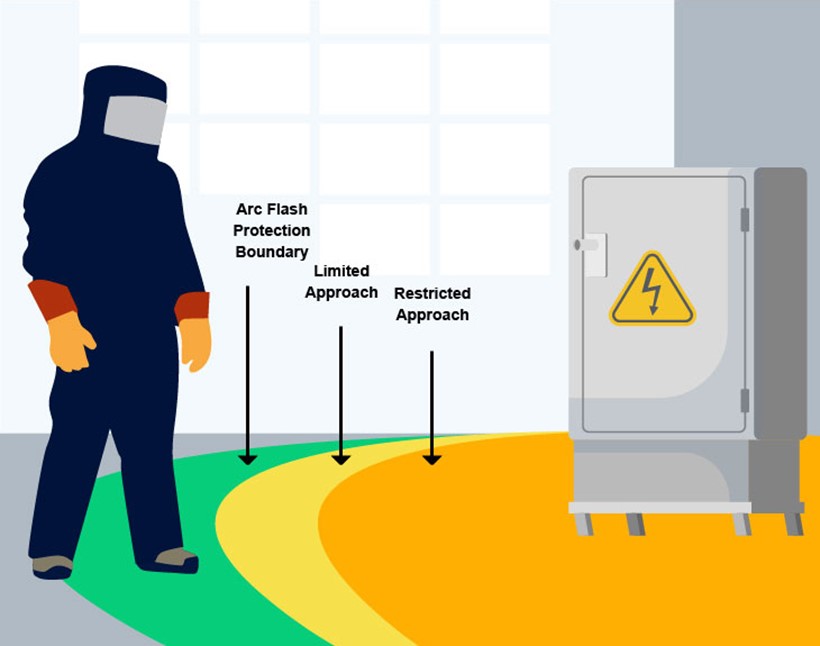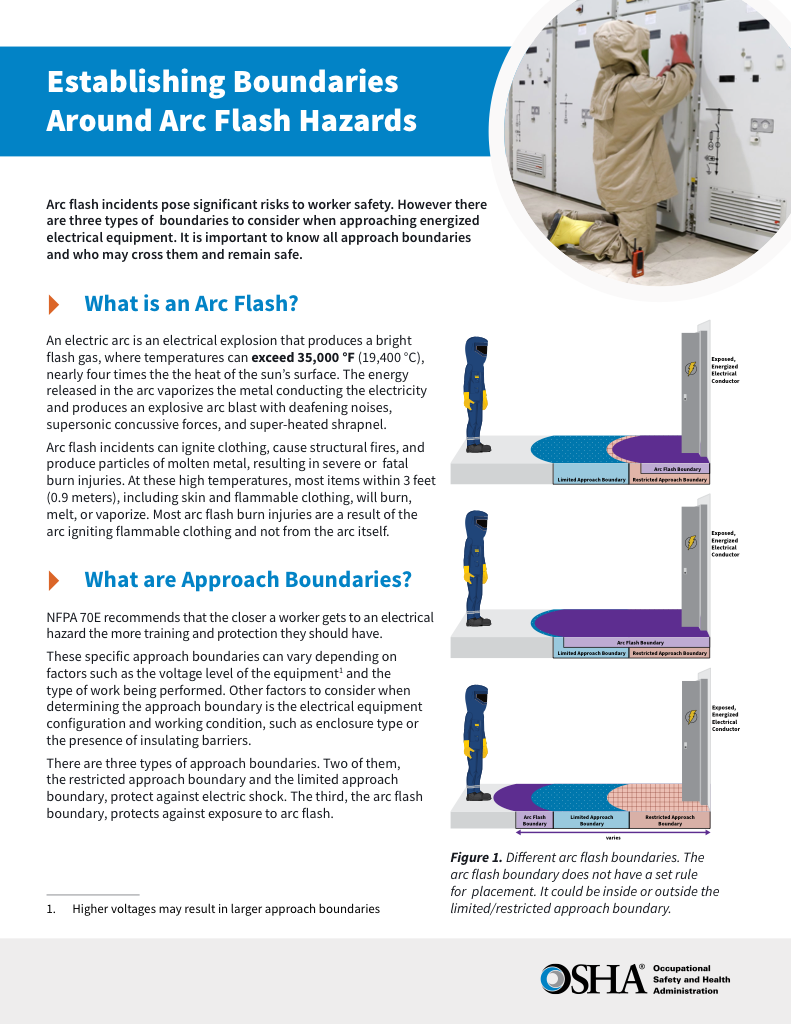Restricted Approach Boundary

CSA Z462 Arc Flash Training - Electrical Safety Essentials
Our customized live online or in‑person group training can be delivered to your staff at your location.

- Live Online
- 6 hours Instructor-led
- Group Training Available
Download Our OSHA 4474 Fact Sheet – Establishing Boundaries Around Arc Flash Hazards

- Understand the difference between arc flash and electric shock boundaries
- Learn who may cross each boundary and under what conditions
- Apply voltage-based rules for safer approach distances
The restricted approach boundary is a shock protection limit defined by NFPA 70E. It marks the distance near exposed energized conductors where only qualified personnel using proper PPE and tools may enter. This boundary helps prevent electrical shock and arc flash injuries.
What is a Restricted Approach Boundary?
✅ A shock protection limit closer than the limited approach boundary
✅ Entry allowed only for qualified workers with approved PPE and training
✅ Requires insulated tools and detailed procedures under NFPA 70E to prevent shock incidents
Understanding the Clearance Zone for Energized Equipment
The restricted approach boundary is part of the NFPA 70E and CSA Z462 framework for managing electrical hazards. This boundary is established at a distance where the risk of electric shock from energized electrical conductors is significantly increased due to potential arc-over or accidental contact. Entry is restricted to qualified electrical workers who are trained, authorized, and equipped with personal protective equipment (PPE) and insulated tools.
How the Restricted Approach Boundary Fits into Shock Protection Limits
This zone lies between the limited approach boundary and the former prohibited approach boundary. Understanding this tiered system of protection—especially how each boundary relates to different voltage levels—is essential for planning safe electrical work and avoiding shock or arc flash incidents. Understanding how the restricted approach boundary fits into the broader system of protection begins with a clear overview of the arc flash boundary, which marks the outermost limit for arc-related hazards.
Restricted Approach Boundary Distances by Voltage Level
The following values represent the official restricted approach boundary distances defined by NFPA 70E and CSA Z462. These measurements specify the minimum safe distance from energized conductors, where only qualified electrical workers with full PPE may enter:
-
301V to 750V: 1 foot 0 inches (0.3 meters)
-
751V to 15kV: 2 feet 2 inches (0.7 meters)
-
15.1kV to 36kV: 2 feet 7 inches (0.8 meters)
These boundaries are critical in assessing shock protection zones and ensuring proper electrical safety procedures based on the system's voltage level.
Electricity Today T&D Magazine Subscribe for FREE

- Timely insights from industry experts
- Practical solutions T&D engineers
- Free access to every issue
Entry Requirements: PPE, Tools, and Training for Shock Protection
To enter the restricted approach boundary, a worker must meet strict criteria:
-
Be a qualified person under NFPA 70E or CSA Z462 definitions
-
Wear voltage-rated gloves and arc-rated clothing
-
Use insulated tools approved for the voltage rating
-
Follow documented procedures and risk assessments
These controls are not optional—they exist to prevent severe injuries or fatalities during energized electrical work. Working within the restricted boundary demands strict adherence to arc flash PPE requirements, including voltage-rated gloves, arc-rated clothing, and insulated tools. The NFPA 70E PPE requirements outline exactly what protective gear must be used when a qualified person crosses into the restricted zone.
NFPA 70E and CSA Z462 Compliance Requirements
Both NFPA 70E: Standard for Electrical Safety in the Workplace and CSA Z462 clearly define the restricted boundary and its purpose in protecting workers from electrical shock hazards. These standards detail:
-
How to calculate approach boundaries
-
Who qualifies to enter
-
What training and PPE are required
-
How to document and audit safety procedures
To learn more about how these standards apply in practice, visit our NFPA 70E training course or CSA Z462 training course.
Working Safely Inside the Restricted Approach Zone
Once inside the restricted zone, all safety measures must be in place. Tasks such as troubleshooting, voltage testing, or maintenance on energized systems demand:
-
A valid energized work permit (if de-energizing is not feasible)
-
A job briefing covering hazards and protective strategies
-
Real-time communication with supervising personnel
Your compliance with the arc flash safety program should support these requirements, ensuring a safe work condition every time energized conductors are accessed. For more detail on how these distances are calculated, refer to our page on how arc flash and shock protection boundaries are determined.
Frequently Asked Questions
What are the requirements for working in the restricted approach boundary?
Working within the restricted zone requires strict adherence to safety protocols designed to minimize the risk of electric shock. These include proper training to become a qualified person, the use of personal protective equipment (PPE) such as voltage-rated gloves, arc-rated clothing, and insulated tools, and compliance with standards like NFPA 70E. Additionally, a documented risk assessment must confirm the necessity of entering the zone, and the worker must use proper procedures to ensure safety while near exposed energized electrical conductors.
Which of the following is required to enter a restricted approach boundary?
To enter the restricted zone, the following are required:
-
Qualified Personnel: Only individuals with the training and skills necessary to work safely near energized parts.
-
Personal Protective Equipment (PPE): This includes voltage-rated gloves, face shields, insulated tools, and other protective gear appropriate for the hazard.
-
Risk Assessment: A formal evaluation of the task and its associated risks to ensure safe practices are followed.
-
Work Authorization: Approval and permits, if applicable, to ensure compliance with organizational and legal requirements.
Who is authorized to go into a restricted boundary?
Only qualified personnel are authorized to enter a restricted boundary. These are individuals who have undergone specialized training to understand the hazards associated with live electrical parts, know how to mitigate these risks, and can demonstrate their competence in electrical safety procedures. Such authorization is crucial to maintain the integrity of safety protocols and ensure that only those equipped to handle these hazards are permitted access. Before entering the restricted approach boundary, it’s essential to verify what constitutes an electrically safe work condition as defined by industry standards.
Who can enter limited and restricted boundaries in OSHA?
According to OSHA regulations, only qualified workers are permitted to enter both the limited and restricted approach boundaries. While the limited zone can allow for supervised access to unqualified workers in specific situations, the restricted zone is strictly off-limits to anyone who is not qualified. This ensures that only those with the necessary expertise and protective equipment work in close proximity to energized parts, reducing the likelihood of accidents and ensuring compliance with workplace safety laws. You can also review step-by-step instructions on how to verify an electrically safe work condition before any work begins inside the restricted zone.
Test Your Knowledge About Arc Flash!
Think you know Arc Flash? Take our quick, interactive quiz and test your knowledge in minutes.
- Instantly see your results and score
- Identify strengths and areas for improvement
- Challenge yourself on real-world electrical topics








